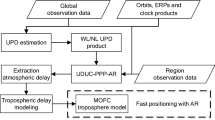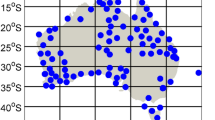Abstract
Real-time single-frequency precise point positioning (PPP) can be significantly augmented by applying high-quality atmospheric corrections. In previous work, the satellite-and-station-specific slant total electron content (STEC) ionospheric corrections, derived from a regional reference network, are commonly used to augment single-frequency PPP for improving positioning accuracy and faster convergence. However, since the users are required to interpolate STEC ionospheric corrections from nearby reference stations, either duplex communication links should be established or all corrections of the reference network must be retrieved, which makes it inefficient to provide augmentation services to many users. Moreover, the regional tropospheric corrections are generally neglected in augmenting real-time single-frequency PPP. In this study, we present a method to estimate and represent tropospheric and ionospheric corrections from a regional reference network, which can be efficiently disseminated to users through a simplex communication link. First, the uncombined dual-frequency PPP, with external ionospheric constraints derived from international GNSS service predicted global ionospheric map, is used for estimating atmospheric delays with observations from a regional GNSS reference network. Then, the atmospheric delays are properly represented to facilitate real-time transmission by applying a polynomial model for the representation of zenith wet tropospheric corrections, and satellite-specific STEC maps for representing the slant ionospheric corrections. The above results in only simple communication links required to retrieve the regional atmospheric corrections for real-time single-frequency PPP augmentation. Observations from a regional network of 30 GNSS reference stations with inter-station distances of about 70 km during a 1-week-long period, including both quiet and active geomagnetic conditions, are used for generating the regional atmospheric corrections. The results indicate that the average root-mean-square errors of the obtained regional tropospheric and ionospheric corrections are better than 0.01 and 0.05 m when compared with those derived from dual-frequency uncombined PPP, respectively. The positioning accuracy of the single-frequency PPP augmented with regional atmospheric corrections is at 0.141 m horizontally and 0.206 m vertically under a 95% confidence level, a significant improvement compared to single-frequency PPP without atmospheric augmentation. The convergence time is also significantly reduced with 70.4% of the positioning sessions achieving instantaneous 3D convergence.











Similar content being viewed by others
References
Ashby N (2003) Relativity in the global positioning system. Living Rev. Relativ 6:1
Banville S, Collins P, Zhang W, Langley RB (2014) Global and regional ionospheric corrections for faster PPP convergence. Navigation 61(2):115–124
Bisnath S, Gao Y (2008) Current state of precise point positioning and future prospects and limitations. IAG Symp 133:615–623
Böhm J, Niell A, Tregoning P, Schuh H (2006) Global mapping function (GMF): a new empirical mapping function based on numerical weather model data. Geophys Res Lett 33(7):L07304
Cabinet Office (2018) Quasi-Zenith satellite system interface specification centimeter level augmentation service. https://qzss.go.jp/en/technical/download/pdf/ps-is-qzss/is-qzss-l6-001.pdf. Accessed 15 Jan 2019
Caissy M, Weber G, Agrotis L, Wübbena G, Hernandez-Pajares M (2011) The IGS real-time pilot project—the development of real-time IGS correction products for precise point positioning. Geophys Res Abstr 13:EGU2011-7472
de Bakker PF, Tiberius CCJM (2017) Real-time multi-GNSS single-frequency precise point positioning. GPS Solut 21(4):1791–1803
Dow JM, Neilan RE, Rizos C (2009) The international GNSS service in a changing landscape of global navigation satellite systems. J Geod 83(3–4):191–198
Ge M, Douša J, Li X, Ramatschi M, Nischan T, Wickert J (2012) A novel real-time precise positioning service system: global precise point positioning with regional augmentation. J Glob Position Syst 11(1):2–10
Jokinen A, Feng S, Milner C, Schuster W, Ochieng W, Hide C, Moore T, Hill C (2011) Precise point positioning and integrity monitoring with GPS and GLONASS. In: Proceedings of European navigation conference 2011, European Group of Institutes of Navigation, London, UK, November 29–December 1, pp 1–12
Kauristie K, Morschhauser A, Olsen N, Finlay CC, McPherron RL, Gjerloev JW, Opgenoorth HJ (2017) On the usage of geomagnetic indices for data selection in internal field modelling. Space Sci Rev 206(1–4):61–90
Kouba J (2009) A guide to using international GNSS service (IGS) products. http://acc.igs.org/UsingIGSProductsVer21.pdf. Accessed 19 Sept 2018
Li P, Zhang X (2014) Integrating GPS and GLONASS to accelerate convergence and initialization times of precise point positioning. GPS Solut 18(3):461–471
Li X, Zhang X, Ge M (2011) Regional reference network augmented precise point positioning for instantaneous ambiguity resolution. J Geophys Res 85:151–158
Li X, Ge M, Douša J, Wickert J (2014) Real-time precise point positioning regional augmentation for large GPS reference networks. GPS Solut 18(1):61–71
Li L, Jia C, Zhao L, Cheng J, Liu J, Ding J (2016) Real-time single frequency precise point positioning using SBAS corrections. Sensors 16(8):1261
Li B, Zhang Z, Shen Y, Yang L (2018) A procedure for the significance testing of unmodeled errors in GNSS observations. J Geod 92(10):1171–1186
Liu T, Yuan Y, Zhang B, Wang N, Tan B, Chen Y (2017) Multi-GNSS precise point positioning (MGPPP) using raw observations. J Geod 91(3):253–268
Liu T, Zhang B, Yuan Y, Li M (2018) Real-time precise point positioning (RTPPP) with raw observations and its application in real-time regional ionospheric vertical TEC modeling. J Geod 92(11):1267–1283
Lou Y, Zheng F, Gu S, Wang C, Guo H, Feng Y (2016) Multi-GNSS precise point positioning with raw single-frequency and dual-frequency measurement models. GPS Solut 20(4):849–862
Malys S, Jensen PA (1990) Geodetic point positioning with GPS carrier beat phase data from the CASA UNO experiment. Geophys Res Lett 17(5):651–654
Nie Z, Yang H, Zhou P, Gao Y, Wang Z (2019) Quality assessment of CNES real-time ionospheric products. GPS Solut 23:11
Petit G, Luzum B (2010) IERS conventions (2010). IERS technical note 36. Verlag des Bundesamts für Kartographie und Geodäsie, Frankfurt am Main, Germany
Rovira-Garcia A, Juan JM, Sanz J, González-Casado G, Ibáñez D (2016) Accuracy of ionospheric models used in GNSS and SBAS: methodology and analysis. J Geod 90:229
Saastamoinen J (1972) Atmospheric correction for troposphere and stratosphere in radio ranging of satellites. In: Henriksen SW, Mancini A, Chovitz BH (eds) The use of artificial satellites for geodesy, vol 15. American Geophysical Union, Washington, pp 247–251
Schaer S (1999) Mapping and predicting the earth’s ionosphere using the global positioning system. Dissertation, University of Bern. Geodätisch–geophysikalische Arbeiten in der Schweiz, vol. 59, Schweizerische Geodätische Kommission, ETH Zurich
Schmid R, Steigenberger P, Gendt G, Ge M, Rothacher M (2007) Generation of a consistent absolute phase-center correction model for GPS receiver and satellite antennas. J Geod 81(12):781–798
Shi C, Gu S, Lou Y, Ge M (2012) An improved approach to model ionospheric delays for single-frequency precise point positioning. Adv Space Res 49(12):1698–1708
Shi J, Xu C, Guo J, Gao Y (2014) Local troposphere augmentation for real-time precise point positioning. Earth Planets Space 66:30
Wu JT, Wu SC, Hajj GA, Bertiger W, Lichten SM (1992) Effects of antenna orientation on GPS carrier phase. Adv Astronaut Sci 76(2):1647–1660
Xiang Y, Gao Y (2017) Improving DCB estimation using uncombined PPP. Navigation 64(4):463–473
Xiang Y, Gao Y, Shi J, Xu C (2019) Consistency and analysis of ionospheric observables obtained from three precise point positioning models. J Geod. https://doi.org/10.1007/s00190-019-01233-1
Xiao G, Li P, Sui L, Heck B, Schuh H (2018) Estimating and assessing Galileo satellite fractional cycle bias for PPP ambiguity resolution. GPS Solut 23(1):3–10
Xu G, Xu Y (2016) GPS: theory, algorithms and applications. Springer, Berlin
Yao Y, Zhang R, Song W, Shi C, Lou Y (2013) An improved approach to model regional ionosphere and accelerate convergence for precise point positioning. Adv Space Res 52(8):1406–1415
Zhang B, Ou J, Yuan Y, Li Z (2012) Extraction of line-of-sight ionospheric observables from GPS data using precise point positioning. Sci China Earth Sci 55(11):1919–1928
Zhang H, Gao Z, Ge M, Niu X, Huang L, Tu R, Li X (2013) On the convergence of ionospheric constrained precise point positioning (IC-PPP) based on undifferential uncombined raw GNSS observations. Sensors 13(11):15708–15725
Zhao Q, Wang Y, Gu S, Zheng F, Shi C, Ge M, Schuh H (2018) Refining ionospheric delay modeling for undifferenced and uncombined GNSS data processing. J Geod 56(3):209–216
Zhou F, Dong D, Li W, Jiang X, Wickert J, Schuh H (2018) GAMP: an open-source software of multi-GNSS precise point positioning using undifferenced and uncombined observations. GPS Solut 22(2):33
Zumberge JF, Heflin MB, Jefferson DC, Watkins MM, Webb FH (1997) Precise point positioning for the efficient and robust analysis of GPS data from large networks. J Geophys Res 102(B3):5005–5017
Acknowledgements
IGS and CODE are acknowledged for providing GNSS products. The authors gratefully thank Iowa Department of Transportation and Steve Milligan for providing access to the IaRTN GNSS data. The International Service of Geomagnetic Indices (ISGI) is acknowledged for providing the Dst and Kp indices. The first author is funded by the China Scholarship Council (CSC) and the Natural Sciences and Engineering Research Council of Canada (NSERC) which are also acknowledged.
Author information
Authors and Affiliations
Corresponding author
Additional information
Publisher's Note
Springer Nature remains neutral with regard to jurisdictional claims in published maps and institutional affiliations.
Rights and permissions
About this article
Cite this article
Zhou, P., Wang, J., Nie, Z. et al. Estimation and representation of regional atmospheric corrections for augmenting real-time single-frequency PPP. GPS Solut 24, 7 (2020). https://doi.org/10.1007/s10291-019-0920-5
Received:
Accepted:
Published:
DOI: https://doi.org/10.1007/s10291-019-0920-5




